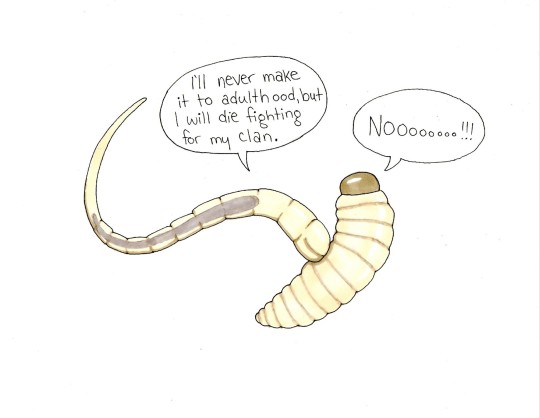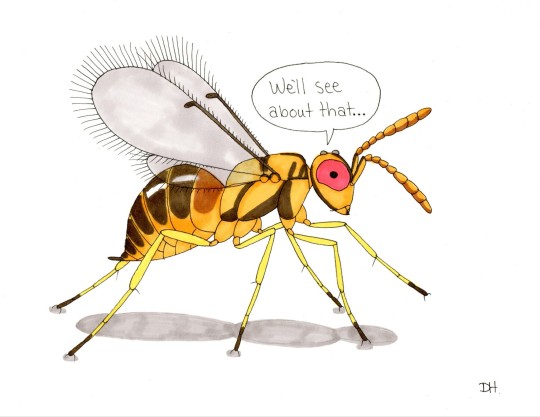#castesystem
Explore tagged Tumblr posts
Text




Copidosoma floridanum is an Encyrtid wasp whose brood is a fascinating example of polyembryony, in which multiple embryos form from a single egg. It is primarily a parasitoid of Noctuid moths in the subfamily Plusiinae. The Encyrtid egg will produce thousands of clone embryos. The mother C. floridanum will sometimes lay one male egg per host, or one female egg, or sometimes both. What's even more fascinating is that the wasp larvae have a caste system: the reproductives and the (precocious) soldiers. The reproductive larvae emerge during the caterpillar's last instar, consume it, and pupate into adult wasps. The soldiers emerge earlier, but never molt and die when the host dies. Their sole purpose is to protect their reproductive siblings from other parasitoid rivals and to kill their own opposite-sex precocious siblings. Since male soldiers compete for resources (caterpillar), by killing some of them off, the sterile soldiers are helping their genes survive by securing more resources for their clone reproductive siblings. In mixed-sex broods, the male larvae will try to hide and encyst themselves in the caterpillar's fat body to escape their murderous sterile sisters. Copidosoma competes with Microgastrine species such as Microplitis demolitor and Glyptapanteles pallipes. C. floridanum demonstrates haplodiploidy where unfertilized eggs become haploid males and fertilized eggs become diploid females. There are both male and female soldiers, but male soldiers tend to be less aggressive towards competitors. However, C. floridanum isn't invincible. There is one competitor, Trichogramma, that is also an egg parasitoid, and only uses the eggs of the moths. The adult wasps emerge long before the caterpillars hatch. When Trichogramma and Copidosoma end up in the same egg, the former usually ends up victorious.
I spent many hours doing research on this topic, but if there are any mistakes, I welcome any corrections!
#hymenoptera#insect#entomology#wasp#wasps#apocrita#parasitica#Microgastrinae#Encyrtidae#Trichogrammatidae#Copidosomafloridanum#Trichogramma#precocious#soldier#reproductive#larvae#castesystem#Plusiinae#Noctuidae#Ichneumonoidea#Chalcidoidea#polyembryonic#Braconidae
155 notes
·
View notes
Text
The Roma caste system, while not a formalized caste system like that found in India, does bear some similarities in terms of social hierarchy and divisions. The Roma people, originally from the Indian subcontinent, migrated to Europe centuries ago, and some aspects of their social structures reflect their Indian heritage.

Here’s an outline of a hypothetical comparison between the two systems, while acknowledging the unique characteristics of each culture:
Indian Caste System:
1. Brahmins (Priests, Scholars): Traditionally involved in spiritual and intellectual pursuits.
2. Kshatriyas (Warriors, Rulers): Responsible for protection and governance.
3. Vaishyas (Merchants, Traders): Engaged in commerce and agriculture.
4. Shudras (Laborers, Service Providers): Served the other varnas through manual labor and service.
5. Dalits (Untouchables): Historically marginalized, often involved in occupations considered impure.
Hypothetical Roma Caste System:
1. Spiritual Leaders (Roma Elders/Advisors): Similar to Brahmins, these are respected figures responsible for maintaining traditions and guiding the community spiritually.
2. Chieftains (Kumpania Leaders): Comparable to Kshatriyas, these leaders govern the community, mediate disputes, and represent their group to outsiders.
3. Traders and Craftspeople: Like the Vaishyas, many Roma are historically associated with commerce (horse trading, metalworking) and artistic crafts (jewelry making, music).
4. Performers and Entertainers: Distinct to Roma culture, this group specializes in music, dance, and storytelling, playing a vital role in preserving cultural identity.
5. Service Workers (Manual Laborers): Similar to Shudras, they undertake various essential, often manual, tasks to support the community.
6. Outcasts/Marginalized (Gadje Relations): While not strictly part of Roma society, interactions with the gadje (non-Roma) often placed certain Roma individuals or subgroups in a marginalized position due to external societal discrimination.
Key Similarities:
• Hereditary Roles: Both systems historically associate roles and occupations with family lineage.
• Cultural Identity: Both systems enforce community boundaries, with marriage and social interaction often restricted within specific groups.
• Marginalization: Lower or “outcast” groups face discrimination and limited social mobility.
Key Differences:
• Flexibility: The Roma caste-like structure is less rigid than the Indian caste system, allowing for greater adaptability depending on local contexts.
• Religious Influence: While the Indian caste system is deeply intertwined with Hinduism, the Roma structure is influenced more by traditions and external societal interactions.
0 notes
Text
#FYI#geography#culture#history#nativeamericans#lifestyle#CasteSystem#society#interactions#spain#Colonizers#europe#whitesettlers#stolenland#disease#language#Encomienda#war#resources
0 notes
Text
The history of casteism in India has long roots, the system called caste emerged and it divides people according to their caste. The word caste is made up of just five characters but it has a huge impact on Indian society.
0 notes
Text

1 note
·
View note
Text

0 notes
Text
0 notes
Text
0 notes
Text


for @castesystem
422 notes
·
View notes
Text

An Otter!Dani for this squeaky sunday
Drawn by my gfff @castesystem
486 notes
·
View notes
Text
Paras Parivaar Charitable Trust: Against Caste System
Paras Parivaar Charitable Trust Aim:
From the bottom of our hearts, we extend a warm welcome to you into the Paras Parivaar Charitable Trust family. In our Sanatan Dharm, this Parivaar was founded and is now being maintained by our Mahant Shri Paras Bhai Ji of Sanatan Dharm to contribute to the welfare of the underprivileged and needy people. Because he consistently states, “happiness of maa is behind their smile.” This idea of Mahant Shri Paras Bhai Ji has become the focus of our family’s daily activities.
The Paras Parivaar Charitable Trust works 365 days a year to lug our Paras Guru’s vision forward. We have helped more than 10 lakh Needy, and thanks to Maa and our Mahant Shri Paras Bhai Ji of Sanatan Dharm, this number is steadily rising. And it is the grandeur of Sanatan Dharm that we strive to assist those who cannot afford to pay for their education or who are food insecure.
Because we usually hear the quote “Unity is Strength” in everyday life, the Paras Parivaar Charitable Trust would like for you to join our family. We are certain that if we all work together as a single family, we will be stronger and more committed to helping more people in need. Serving an increasing number of individuals in need will enable us to carve out a large place in the heart of our Maa. So, join the Paras Parivaar now for the chance of a lifetime to make the poor and needy smile widely.
Working hard to boost the lives of the poor and needy would also help us reduce the rate of poverty and increase the rate of education in our nation. In addition to providing aid to those in need, our Mahant Shri Paras Bhai Ji wants to educate them so that they may become self-sufficient and contribute to the cause. join our Paras Parivaar Charitable Trust and aid those in need and destitute with what they need for food, shelter, and education.
The caste system in India is a deeply rooted social structure that has perpetuated injustice and inequity over millennia. Despite legal frameworks designed to eliminate caste discrimination, social stigma and institutional inequities persist. At Paras Parivaar Charitable Trust, we believe it is vital to raise awareness and promote a caste-free society. Here’s how we can successfully address this issue.

Knowing About Caste
Casteism is a systemic issue that affects millions of individuals. It divides society into hierarchical groups, with those at the bottom, primarily Dalits, facing extreme prejudice and marginalization. This discrimination takes numerous forms, including limited access to education, employment, and basic human rights. The caste system has evolved over time, but its roots remain deeply embedded in cultural and religious practices, making it a tough issue to overcome.
The Value of Awareness and Education
Education is one of the most effective ways to overcome casteism. Awareness campaigns can assist eliminate misunderstandings and stereotypes regarding various castes. Educational institutions should incorporate discussions about caste bias in their curricula to foster a culture of understanding and empathy among students.
Important Initiatives:
1.Workshops and seminars: Organize activities to educate people on the history and implications of the caste system.
2.Community Engagement: Create forums for interaction amongst different caste groups to promote understanding and solidarity.
Increasing Legal Defenses
Even though caste discrimination is illegal in India, enforcing these restrictions remains challenging. It is critical to improve these rules and ensure their proper implementation.
Suggestions:
Caste Census: Conduct a caste census to gather information that can be utilized to shape legislation and actions aimed at minimizing caste discrimination.
Judicial Training: To ensure that matters are handled delicately, inform law enforcement and judicial authorities about caste discrimination.
Financial Empowerment
Economic opportunities are crucial for breaking the cycle of caste discrimination. Initiatives aimed at elevating poor communities can have a big societal impact.
Recommendations for Action:
Launch programs that provide vocational training and entrepreneurship assistance to Dalits and other marginalized groups.
Financial incentives: Offer grants and loans to lower-caste entrepreneurs, boosting economic independence and self-sufficiency.
Changes in Policy and Advocacy
Advocacy is critical for supporting policy reforms that eliminate caste-based discrimination. Organizations such as Paras Parivaar Charitable Trust may take the lead in advocating for more inclusive laws.
Areas of Focus:
International Attention: To gain support from other countries, highlight caste prejudice in international forums and draw parallels with other forms of discrimination.
Policy recommendations: Work with policymakers to develop and execute solutions that address the root causes of casteism.
Conclusion
The fight against casteism requires a joint effort from all sectors of society. By raising awareness, improving legal protections, increasing economic empowerment, and campaigning for legislative changes, we may work toward a future free of caste discrimination. At Paras Parivaar Charitable Trust, we are an organization committed to this cause and invite everyone to join us in creating a more equitable society for all. Together, we can challenge the status quo and pave the way for a caste-free India.
0 notes
Text

Commission for Ayase feat. @castesystem
108 notes
·
View notes
Text
youtube
The History of casteism in India
The history of casteism in India has long roots, the system called caste emerged and it divides people according to their caste. The word caste is made up of just five characters but it has a huge impact on Indian society.
1 note
·
View note
Text

wheeee finished YCH for @castesystem!
💜 My Website! 💜
#Buoyantmaid#Transformation#TF#Pool Toys#Pool Toy#PoolToys#Inflationart#Inflation Art#Taurposting#Merfolk
61 notes
·
View notes
Text
0 notes
Text





#जाति_मनुष्यकी_अशांति_का_कारण
#casteism #hinduism #atheism #reelschallenge #jatipratha #untouchability #equality #religiousequality #caste #viral #viralvideos #viralpost #trendingreels #casteisminindia #castepolitics #castesystem #जातिवाद #socialjustice
#SantRampalJiMaharaj
#santrampalji is trueguru#santrampaljimaharaj#kabir is real god#सत् साहेब जय हो बंदी छोड की#kabirisgod#हिन्दु साहेबान नाही समजे ग��ता वेद पुरान#santrampaljiquotes#sant rampal ji maharaj#youtube#saintrampalji
16 notes
·
View notes